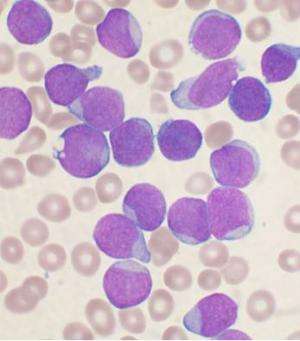From eye drops to potential leukaemia treatment

An active ingredient in eye drops that were being developed for the treatment of a form of eye disease has shown promise for treating an aggressive form of blood cancer. Scientists at the Wellcome Sanger Institute, University of Cambridge, University of Nottingham and their collaborators have found that this compound, which targets an essential cancer gene, could kill leukaemia cells without harming non-leukemic blood cells.
The results, published today in Nature Communications reveal a potential new treatment approach for an aggressive blood cancer with a poor prognosis.
Acute myeloid leukaemia (AML) is a form of blood cancer that affects people of all ages, often requiring months of intensive chemotherapy and prolonged hospital admissions. It develops in cells in the bone marrow crowding out the healthy cells, in turn leading to life-threatening infections and bleeding.
Mainstream AML treatments have remained unchanged for over thirty years, with the current treatment being chemotherapy, and the majority of people's cancer cannot be cured. A subtype of AML, driven by rearrangements in the MLL gene has a particularly bad prognosis.
In a previous study, researchers at the Sanger Institute developed an approach, based on CRISPR gene editing technology, which helped them identify more than 400 genes as possible therapeutic targets for different subtypes of AML. One of the genes, SRPK1, was found to be essential for the growth of MLL-rearranged AML. SRPK1 is involved in a process called RNA splicing, which prepares RNA for translation into proteins, the molecules that conduct the majority of normal cellular processes, including growth and proliferation.
In a new study, Sanger Institute researchers and their collaborators set out to work out how inhibition of SRPK1 can kill AML cells and whether it has therapeutic potential in this disease. They first showed that genetic disruption of SRPK1 stopped the growth of MLL-rearranged AML cells and then went on to study the compound SPHINX31, an inhibitor of SRPK1, which was being used to develop an eye drop treatment for retinal neovascular disease—the growth of new blood vessels on the retinal surface that bleed spontaneously and cause vision loss.
The team found that the compound strongly inhibited the growth of several MLL-rearranged AML cell lines, but did not inhibit the growth of normal blood stem cells. They then transplanted patient-derived human AML cells into immunocompromised mice and treated them with the compound. Strikingly, the growth of AML cells was strongly inhibited and the mice did not show any noticeable side effects.
Dr. George Vassiliou, joint leader of the research from the Wellcome Sanger Institute and the Wellcome-MRC Cambridge Stem Cell Institute, said: "We have discovered that inhibiting a key gene with a compound being developed for an eye condition can stop the growth of an aggressive form of acute myeloid leukaemia without harming healthy cells. This shows promise as a potential approach for treating this aggressive leukaemia in humans."
SRPK1 controls the splicing of RNA in the production of new proteins. An example of a gene that is affected when SRPK1 is blocked is BRD4, a well-known gene that maintains AML. Inhibiting SRPK1 causes the main form of BRD4 to switch to another form, a change that is detrimental to AML growth.
Dr. Konstantinos Tzelepis, joint lead author from the Wellcome Sanger Institute and University of Cambridge, said: "Our study describes a novel mechanism required for leukaemia cell survival and highlights the therapeutic potential of SRPK1 inhibition in an aggressive type of AML. Targeting this mechanism may be effective in other cancers where BRD4 and SRPK1 play a role, such as metastatic breast cancer."
Professor David Bates, from the University of Nottingham and co-founder of biotech company Exonate, which develops eye drops for retinal diseases, said: "When Dr. Vassiliou told me that SRPK1 was required for the survival of a form of AML, I immediately wanted to work with him to find out if our inhibitors could actually stop the leukaemia cells growing. The fact that the compound worked so effectively bodes well for its potential development as a new therapy for leukaemia. It will take some time, but there is real promise for a new treatment on the horizon for patients with this aggressive cancer."
More information: Konstantinos Tzelepis et al, SRPK1 maintains acute myeloid leukemia through effects on isoform usage of epigenetic regulators including BRD4, Nature Communications (2018). DOI: 10.1038/s41467-018-07620-0


















